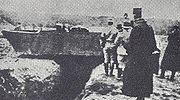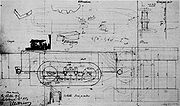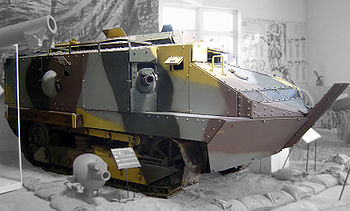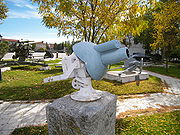
Schneider CA1
Encyclopedia
The Schneider CA1 was the first French
tank
. It was inspired by the need to overcome the stalemate of the trench warfare
of the Great War
.
was a large arms manufacturer in France. Having been given the order to develop heavy artillery tractors, in January 1915 the company sent out its chief designer, Eugène Brillié, to investigate tracked tractors from the American Holt Company, at that time participating in a test programme in England
. On his return Brillié, who had earlier been involved in designing armoured cars for Spain
, convinced the company management to initiate studies on the development of a Tracteur blindé et armé (armoured and armed tractor), based on the Baby Holt chassis, two of which were ordered.
Experiments on the Holt caterpillar tracks started in May 1915 at the Schneider plant with a 75 hp wheel-directed model and the 45 hp integral caterpillar Baby Holt, showing the superiority of the latter. On 16 June, new experiments followed in front of the President of the Republic
Raymond Poincaré
, leading to the order of 10 armoured tracked vehicles for further testing. In July 1915 the Schneider programme was combined with an official one for the development of an armoured barbed wire cutter by engineer and Member of Parliament Jules-Louis Breton
, the Breton-Prétot machine
. Ten of the fifteen available Baby Holt vehicles were to be armoured and fitted with the wire cutter. On 10 September, new experiments were made for Commander Ferrus, an officer who had been involved in the study (and ultimate rejection) of the Levavasseur tank project
in 1908.
 On 9 December 1915 in the Souain experiment
On 9 December 1915 in the Souain experiment
, a prototype armoured tank, a Baby Holt chassis with boiler-plate armour, was demonstrated to the French Army. Among the onlookers were General Philippe Pétain
, and Colonel Jean Baptiste Eugène Estienne (1860–1936), an artillery man and engineer held in very high regard throughout the army for his unmatched technological and tactical expertise. The results of the prototype tank were excellent, displaying remarkable mobility in the difficult terrain of the former battlefield of Souain. The length of the Baby Holt however appeared to be too short to bridge German trenches, justifying the development of longer caterpillar tracks for the French tank project. For Estienne the vehicle shown embodied concepts about AFVs which he had been advocating since August 1914.

 On 12 December he presented to the High Command a plan to form an armoured force, equipped with tracked vehicles. This plan met with approbation and in a letter dated 31 January 1916 Commander-in-chief
On 12 December he presented to the High Command a plan to form an armoured force, equipped with tracked vehicles. This plan met with approbation and in a letter dated 31 January 1916 Commander-in-chief
Joffre ordered the production of 400 tanks of the type designed by Estienne, although the actual production order of 400 Schneider CA1 was made a bit later on 25 February 1916, at a price of 56,000 French franc
s per vehicle. In January it had been decided not to use the Baby Holt chassis, but the longer 75 hp Holt tractor; for this the armoured superstructure had to be completely changed, which was done in an army workshop in February. The first vehicle of the production series was delivered on 5 September. Meanwhile, production had shifted to the SOMUA company, a dependency of Schneider.
 To the modern eye, the tank is hardly recognizable as such. It has no turret, and its not very prominent main armament, a fortification petard
To the modern eye, the tank is hardly recognizable as such. It has no turret, and its not very prominent main armament, a fortification petard
mortar, the 75 mm Blockhaus Schneider, was placed in a sponson
in the right front corner. Two 8 mm Hotchkiss
machine gun
s, projecting from the flanks in ballmounts, complement the small gun. Another awkward feature is the overhang of the frontal part of the chassis which had been designed to crush down barbed wire. However this feature caused the tank to ditch itself readily. The fighting compartment is extremely cramped: the crew of six was mostly flat on their bellies in a 90 cm space between the roof and the 60 hp (45 kW) engine. Luckily, top speed was only 8 km/h. All this was protected by 11 mm steel plate, later improved by a spaced armour of 5.5 mm, raising the weight to 13.5 tons.
somewhat — it took them more time to build larger factories — deploying their tanks for the first time on 16 April 1917 at Berry-au-Bac
during the infamous Nivelle Offensive
. Their first use was a complete disaster as many of the roughly 130 tanks were cut to pieces by German
artillery. Twenty units with Schneider tanks were formed, named Artillerie Spéciale 1–20, under the overall command of the now brigadier Estienne. In 1918 these "old" tanks were gradually phased out in favour of the new Renault FT-17
, but production only ended in August 1918, when exactly 400 had been built including the prototype
. At least one Schneider was delivered to Italy
, which after testing abandoned the plan to build 1500 of them.
 After the war, the tanks were rebuilt as recovery vehicles and tank transporters. Six were sold to Spain in 1922, from 1923 to 1926 fighting in Morocco, the surviving four vehicles later taking part in the Spanish Civil War
After the war, the tanks were rebuilt as recovery vehicles and tank transporters. Six were sold to Spain in 1922, from 1923 to 1926 fighting in Morocco, the surviving four vehicles later taking part in the Spanish Civil War
near Toledo
on the side of the Republicans. The only surviving vehicle, at the Musée des Blindés
in Saumur
, is also the world's oldest tank in running condition. It was preserved in the Aberdeen Proving Ground Ordnance Museum in Maryland, USA and later donated to France for restoration.

France
The French Republic , The French Republic , The French Republic , (commonly known as France , is a unitary semi-presidential republic in Western Europe with several overseas territories and islands located on other continents and in the Indian, Pacific, and Atlantic oceans. Metropolitan France...
tank
Tank
A tank is a tracked, armoured fighting vehicle designed for front-line combat which combines operational mobility, tactical offensive, and defensive capabilities...
. It was inspired by the need to overcome the stalemate of the trench warfare
Trench warfare
Trench warfare is a form of occupied fighting lines, consisting largely of trenches, in which troops are largely immune to the enemy's small arms fire and are substantially sheltered from artillery...
of the Great War
World War I
World War I , which was predominantly called the World War or the Great War from its occurrence until 1939, and the First World War or World War I thereafter, was a major war centred in Europe that began on 28 July 1914 and lasted until 11 November 1918...
.
Caterpillar development
Schneider & Co.Schneider Electric
Schneider Electric is a French global company. It was founded in 1836 by two brothers, Eugène and Adolphe Schneider.In the first part of the 20th century, Schneider et Cie associated itself with Westinghouse Systems, a major international electrical group at the time. The group began manufacturing...
was a large arms manufacturer in France. Having been given the order to develop heavy artillery tractors, in January 1915 the company sent out its chief designer, Eugène Brillié, to investigate tracked tractors from the American Holt Company, at that time participating in a test programme in England
England
England is a country that is part of the United Kingdom. It shares land borders with Scotland to the north and Wales to the west; the Irish Sea is to the north west, the Celtic Sea to the south west, with the North Sea to the east and the English Channel to the south separating it from continental...
. On his return Brillié, who had earlier been involved in designing armoured cars for Spain
Spain
Spain , officially the Kingdom of Spain languages]] under the European Charter for Regional or Minority Languages. In each of these, Spain's official name is as follows:;;;;;;), is a country and member state of the European Union located in southwestern Europe on the Iberian Peninsula...
, convinced the company management to initiate studies on the development of a Tracteur blindé et armé (armoured and armed tractor), based on the Baby Holt chassis, two of which were ordered.
Experiments on the Holt caterpillar tracks started in May 1915 at the Schneider plant with a 75 hp wheel-directed model and the 45 hp integral caterpillar Baby Holt, showing the superiority of the latter. On 16 June, new experiments followed in front of the President of the Republic
President of the Republic
The President of the Republic is a title used for heads of government or heads of state in some republics:*President of Argentina, the Presidente de la República Argentina* President of Brazil, the Presidente da República Federativa do Brasil...
Raymond Poincaré
Raymond Poincaré
Raymond Poincaré was a French statesman who served as Prime Minister of France on five separate occasions and as President of France from 1913 to 1920. Poincaré was a conservative leader primarily committed to political and social stability...
, leading to the order of 10 armoured tracked vehicles for further testing. In July 1915 the Schneider programme was combined with an official one for the development of an armoured barbed wire cutter by engineer and Member of Parliament Jules-Louis Breton
Jules-Louis Breton
Jules-Louis Breton was a chemist-inventor and a French politician. He was a representative of the French Assembly, and the proponent of the Breton-Pretot machine, a wire-cutting armoured vehicle developed in France from November 1914. The vehicle was developed with M...
, the Breton-Prétot machine
Breton-Prétot machine
The Breton-Prétot machine was a wire-cutting armoured vehicle developed in France from November 1914. The vehicle was developed by Mr. Prétot, engineer, and Jules-Louis Breton, representative to the French Assembly.-Background:...
. Ten of the fifteen available Baby Holt vehicles were to be armoured and fitted with the wire cutter. On 10 September, new experiments were made for Commander Ferrus, an officer who had been involved in the study (and ultimate rejection) of the Levavasseur tank project
Levavasseur project
The Levavasseur project was an early project for a tank designed in 1903 by the French Captain Levavasseur of the 6th Artillery Battalion, described as a "automobile canon project" . It is considered as the first description, made by a soldier, of what was going to become the tank...
in 1908.
Souain experiment

Souain experiment
The Souain experiment was a French military experiment using a prototype tank, in the former battlefield of Souain, in northeastern France, on 9 December 1915. The experiment has a decisive influence of the French tank program and initiated the design and order of the first French operational tank,...
, a prototype armoured tank, a Baby Holt chassis with boiler-plate armour, was demonstrated to the French Army. Among the onlookers were General Philippe Pétain
Philippe Pétain
Henri Philippe Benoni Omer Joseph Pétain , generally known as Philippe Pétain or Marshal Pétain , was a French general who reached the distinction of Marshal of France, and was later Chief of State of Vichy France , from 1940 to 1944...
, and Colonel Jean Baptiste Eugène Estienne (1860–1936), an artillery man and engineer held in very high regard throughout the army for his unmatched technological and tactical expertise. The results of the prototype tank were excellent, displaying remarkable mobility in the difficult terrain of the former battlefield of Souain. The length of the Baby Holt however appeared to be too short to bridge German trenches, justifying the development of longer caterpillar tracks for the French tank project. For Estienne the vehicle shown embodied concepts about AFVs which he had been advocating since August 1914.
Estienne's proposal


Commander-in-Chief
A commander-in-chief is the commander of a nation's military forces or significant element of those forces. In the latter case, the force element may be defined as those forces within a particular region or those forces which are associated by function. As a practical term it refers to the military...
Joffre ordered the production of 400 tanks of the type designed by Estienne, although the actual production order of 400 Schneider CA1 was made a bit later on 25 February 1916, at a price of 56,000 French franc
French franc
The franc was a currency of France. Along with the Spanish peseta, it was also a de facto currency used in Andorra . Between 1360 and 1641, it was the name of coins worth 1 livre tournois and it remained in common parlance as a term for this amount of money...
s per vehicle. In January it had been decided not to use the Baby Holt chassis, but the longer 75 hp Holt tractor; for this the armoured superstructure had to be completely changed, which was done in an army workshop in February. The first vehicle of the production series was delivered on 5 September. Meanwhile, production had shifted to the SOMUA company, a dependency of Schneider.
Designation
The name of the tank was Schneider CA. The meaning of "CA" is uncertain. Later it was usually understood to mean Char d'Assaut (literally "chariot" and today the full word for "tank"). For several reasons this interpretation is dubious. Firstly, the designation predates by some months the first known usage of char as "tank". Secondly, word order would be unusual: in French the normal order is Char d'Assaut Schneider. Thirdly, at the time the letter codes at the end were normally used to indicate consequent prototypes. We know the first army prototype based on a lengthened 75 hp Holt was called the Tracteur A, a second shortened Schneider prototype with tail the Tracteur B and that the type as produced was again different from that second prototype. It is plausible that the code means "third type" (C) in its first (A) production version; a further indication for this lies in the fact that it was not uncommon to use a reversed order: AC.Description

Petard
A petard was a small bomb used to blow up gates and walls when breaching fortifications. The term has a French origin and dates back to the sixteenth century...
mortar, the 75 mm Blockhaus Schneider, was placed in a sponson
Sponson
Sponsons are projections from the sides of a watercraft, for protection, stability, or the mounting of equipment such as armaments or lifeboats, etc...
in the right front corner. Two 8 mm Hotchkiss
Hotchkiss machine gun
Hotchkiss machine gun:*Hotchkiss M1909, light machine gun also known as the "Hotchkiss Mark I" in British service*Hotchkiss M1914, medium machine gun*Hotchkiss M1922, light machine gun*13.2 mm Hotchkiss machine gun, heavy machine gun...
machine gun
Machine gun
A machine gun is a fully automatic mounted or portable firearm, usually designed to fire rounds in quick succession from an ammunition belt or large-capacity magazine, typically at a rate of several hundred rounds per minute....
s, projecting from the flanks in ballmounts, complement the small gun. Another awkward feature is the overhang of the frontal part of the chassis which had been designed to crush down barbed wire. However this feature caused the tank to ditch itself readily. The fighting compartment is extremely cramped: the crew of six was mostly flat on their bellies in a 90 cm space between the roof and the 60 hp (45 kW) engine. Luckily, top speed was only 8 km/h. All this was protected by 11 mm steel plate, later improved by a spaced armour of 5.5 mm, raising the weight to 13.5 tons.
Operational history
As their production numbers were more ambitious the French lagged behind the BritishUnited Kingdom
The United Kingdom of Great Britain and Northern IrelandIn the United Kingdom and Dependencies, other languages have been officially recognised as legitimate autochthonous languages under the European Charter for Regional or Minority Languages...
somewhat — it took them more time to build larger factories — deploying their tanks for the first time on 16 April 1917 at Berry-au-Bac
Berry-au-Bac
Berry-au-Bac is a commune in the department of Aisne in Picardy in northern France.-References:*...
during the infamous Nivelle Offensive
Nivelle offensive
The Nivelle Offensive was a 1917 French attack on the Western Front in the First World War. Promised as the assault that would end the war within 48 hours, with casualties expected of around 10,000 men, it failed on both counts. It was a three-stage plan:...
. Their first use was a complete disaster as many of the roughly 130 tanks were cut to pieces by German
Germany
Germany , officially the Federal Republic of Germany , is a federal parliamentary republic in Europe. The country consists of 16 states while the capital and largest city is Berlin. Germany covers an area of 357,021 km2 and has a largely temperate seasonal climate...
artillery. Twenty units with Schneider tanks were formed, named Artillerie Spéciale 1–20, under the overall command of the now brigadier Estienne. In 1918 these "old" tanks were gradually phased out in favour of the new Renault FT-17
Renault FT-17
The Renault FT, frequently referred to in post-WWI literature as the "FT-17" or "FT17" , was a French light tank; it is among the most revolutionary and influential tank designs in history...
, but production only ended in August 1918, when exactly 400 had been built including the prototype
Prototype
A prototype is an early sample or model built to test a concept or process or to act as a thing to be replicated or learned from.The word prototype derives from the Greek πρωτότυπον , "primitive form", neutral of πρωτότυπος , "original, primitive", from πρῶτος , "first" and τύπος ,...
. At least one Schneider was delivered to Italy
Italy
Italy , officially the Italian Republic languages]] under the European Charter for Regional or Minority Languages. In each of these, Italy's official name is as follows:;;;;;;;;), is a unitary parliamentary republic in South-Central Europe. To the north it borders France, Switzerland, Austria and...
, which after testing abandoned the plan to build 1500 of them.
After World War I

Spanish Civil War
The Spanish Civil WarAlso known as The Crusade among Nationalists, the Fourth Carlist War among Carlists, and The Rebellion or Uprising among Republicans. was a major conflict fought in Spain from 17 July 1936 to 1 April 1939...
near Toledo
Toledo, Spain
Toledo's Alcázar became renowned in the 19th and 20th centuries as a military academy. At the outbreak of the Spanish Civil War in 1936 its garrison was famously besieged by Republican forces.-Economy:...
on the side of the Republicans. The only surviving vehicle, at the Musée des Blindés
Musée des Blindés
The Musée des Blindés or Musée Général Estienne is a tank museum located in the Loire Valley of France, in the city of Saumur. It is one of the world's largest tank museums....
in Saumur
Saumur
Saumur is a commune in the Maine-et-Loire department in western France.The historic town is located between the Loire and Thouet rivers, and is surrounded by the vineyards of Saumur itself, Chinon, Bourgueil, Coteaux du Layon, etc...
, is also the world's oldest tank in running condition. It was preserved in the Aberdeen Proving Ground Ordnance Museum in Maryland, USA and later donated to France for restoration.


